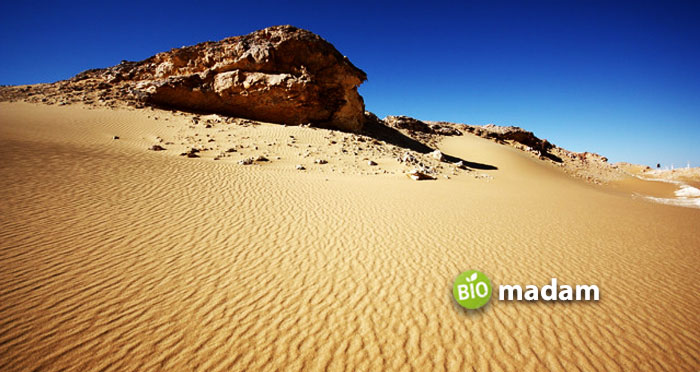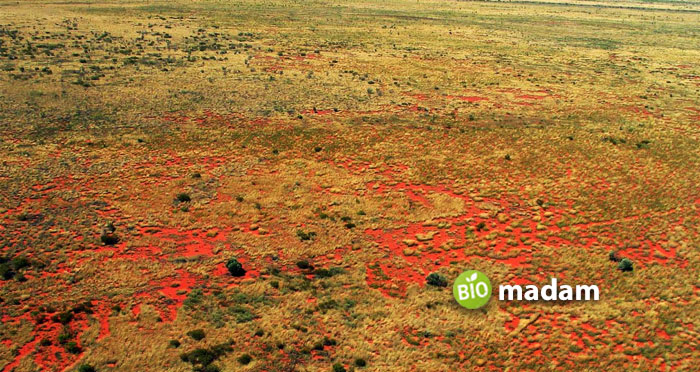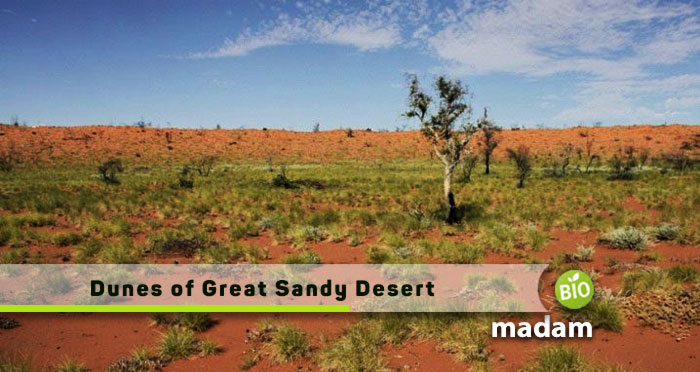Spanning across the remote Australian outback, the Great Sandy Desert awaits intrepid travelers seeking adventure and discovery. This vast expanse of shifting red sand dunes, rocky gorges, and sparse grasslands offers a landscape brimming with mystique and allure. Escape the well-trodden tourist trails and embark on a journey to uncover the Great Sandy’s hidden gems. Sleep beneath endless stars, learn about indigenous culture and marvel at nature’s raw beauty as you traverse massive dunes in four-wheel drives.
From experiencing spirited sunsets on a camelback ride to exploring ancient gorge art, a tour through the sweeping Sahara-like dunes provides rare glimpses into Australia’s storied Outback. This is a realm best navigated with wonder, curiosity, and deep respect for the land and its traditional custodians. In this article, we’ll highlight the top ways to explore the magnificent dunes of the Great Sandy Desert.
Where is the Great Sandy Desert?
The Great Sandy Desert, the second-largest of the top deserts in Australia, sprawls across the northeastern part of Western Australia, extending into the Pilbara and southern Kimberley regions and reaching east into the Northern Territory. Covering an expansive area of approximately 284,993 square kilometers (110,036 square miles) – answering the question of ‘how big is the Great Sandy Desert’ – the landscape captivates with its grandeur beneath the southern hemisphere’s vast skies.
Bordered by the Kimberley region to the north and the Pilbara to the west, the Great Sandy Desert shares its boundaries with the Tanami Desert to the east and the Gibson Desert to the south. A notable convergence occurs at the Kata Tjuta Uluru National Park, where the Great Sandy Desert meets the Gibson and Tanami deserts, creating a landscape of mystique and timeless allure.
Physical Features of the Desert
Let’s take a trip through the Great Sandy Desert, an amazing place in Australia. We’ll see huge sand dunes that stretch for miles, mysterious bare patches called “fairy circles”, and Wolfe Creek Crater, formed long ago when a meteorite crashed into the desert.
- Large Ergs and Longitudinal Dunes: In the heart of the Great Sandy Desert, the landscape unveils a breathtaking spectacle of nature’s artistry. Vast ergs, reminiscent of expansive sand seas, stretch across the terrain, creating a mesmerizing panorama. Additionally, the presence of sprawling longitudinal dunes adds to the desert’s allure, showcasing the sculpted elegance of the ever-shifting sands.
- Wolfe Creek Meteorite Impact Crater: A geographical wonder gracing the northeastern part of the desert is the Wolfe Creek meteorite impact crater. This significant feature stands as a testament to the cosmic dance between celestial bodies and our earthly home. Its presence adds a unique geological dimension to the Great Sandy Desert, leaving an indelible mark on the canvas of the arid landscape.
- Enigmatic “Fairy Circles”: Venturing into the western reaches of the Great Sandy Desert reveals a mysterious phenomenon known as “fairy circles.” These circular patches, ranging from 22 to 39 feet in diameter, captivate observers with their barren centers surrounded by a ring of stimulated grass growth. The enigma of these formations invites contemplation, sparking curiosity about the forces at play and echoing the whispers of time in the vast desert expanse.

Climate of the Great Sandy Desert
The Great Sandy Desert paints a narrative of climatic extremes, where the arid, tropical climate in the north contrasts with the temperate–subtropical climate in the south. This climatic dichotomy weaves a tale of unpredictability, showcasing the delicate dance between dryness and sporadic rainfall.
Arid, Tropical Climate in the North
The northern reaches of the Great Sandy Desert bear the stamp of an arid, tropical climate. The climate’s defining feature is its high variability and unpredictability. Historical data spanning from 1890 to 2005 reveals a median rainfall of 223 mm from April to March. The frequent droughts, fueled by scorching temperatures and a rapid evaporation rate, characterize the northern expanse.
Monsoons and Tropical Cyclones
Despite the aridity, the Great Sandy Desert experiences a surprising interlude of rainfall. The dance of rain begins with the arrival of monsoons, affecting the northern parts during the wet season from November to April. Thunderstorms become a spectacle, adding a dramatic touch to the landscape. Tropical cyclones also contribute to the erratic rainfall pattern, providing temporary relief from the pervasive dryness.
Winters
Winters in the Great Sandy Desert are fleeting but pleasant, marked by short and warm spells. Daytime temperatures range from 25 to 30 °C (77 to 86 °F), creating a mild respite from the scorching heat of other seasons. Frost is a rare visitor, making only occasional appearances in the regions bordering the Gibson Desert.
Balancing Scarcity and Abundance
The average yearly rainfall, standing at about 250 mm, becomes a mere tease in the face of the vast evaporation cycle. This delicate balance between rainfall and evaporation defines the desert’s climate. The monsoons and sporadic rainfall offer glimpses of abundance, only to be swiftly countered by the relentless sun, emphasizing the desert’s resilience in the face of climatic extremes.
Population and Culture
The Great Sandy Desert is sparsely inhabited, with the main populations being Aboriginal Australian communities and mining towns. This desert region is located in the central northern part of Western Australia, stretching into the southern Northern Territory.
The Aboriginal people of the desert belong to two major groups – the Martu in the western part and the Pintupi in the east. They speak various Western Desert languages. The Martu are the traditional custodians of a large portion of central Western Australia, extending from the Great Sandy Desert northwards to around Wiluna in the south. Across this territory, the Martu people share common law, culture, and language.
Many of these indigenous communities were displaced from their homelands during the 20th century and forced to relocate to settlements like Papunya in the Northern Territory.
Fauna and Flora
The Great Sandy Desert is home to a unique variety of plant and animal life that has adapted to survive the harsh, arid conditions. While the vegetation is sparse, spinifex grasses dominate the landscape. Lizards, dingoes, and camels are some of the wildlife inhabiting the shifting sands. However, invasive species introduced to the desert disrupt the delicate ecological balance.
Plants in the Great Sandy Desert
- Spinifex grass dominates the vegetation, covering large swaths of the desert and demonstrating resilience in the harsh climate.
- Other desert plants like acacia and desert oak trees manage to survive in the arid conditions.
- After rare rainfall events, colorful wildflowers may briefly bloom.
Animals in the Great Sandy Desert
- Feral camels, dingoes, and bilbies roam the sandy landscapes.
- Many lizard species like the desert skink and the thorn-tailed gecko have adapted to the dry habitat.
- Unfortunately, invasive predator species including cats, foxes, camels, and rabbits have been introduced. These disrupt the fragile balance of the desert ecosystem.
What Environmental Challenges Do Great Sandy Desert Face?
The Great Sandy Desert’s environment is shaped by interconnected factors. This vast desert has a complex ecology where scarce water, shifting sands, droughts, and floods interact. The connections between climate, plants, animals, and humans impact the landscape over time. Below is the main focus on unraveling the intricate relationships within this delicate desert ecosystem.
Desertification
Definition: The process of fertile land transforming into desert due to human activities and climate change.
Impact: Desertification contributes to soil degradation, reduced vegetation cover, and increased vulnerability to extreme weather conditions, affecting both the ecosystem and local communities.
Water Scarcity
Issue: Desert environments inherently have limited water sources, making them susceptible to water scarcity, particularly during drought periods.
Impact: Water scarcity poses challenges for both the natural ecosystem and human communities, impacting biodiversity and essential water needs.
Human-Made Problems
Factors
- Over-cultivation
- Poorly drained irrigation systems
- Mismanagement of available water
- Digging for fossil fuels
- Introduction of invasive species
Impact: Human-induced activities contribute to environmental degradation, affecting soil quality, water resources, and overall ecosystem health.
Soil Erosion
Cause: Human activities, particularly the removal of plants during urban development, can lead to soil erosion.
Impact: Soil erosion disrupts the stability of the landscape, contributing to the loss of fertile topsoil, decreased vegetation, and increased vulnerability to environmental changes.
Climate Variability
Challenge: Arid areas, including the Great Sandy Desert, are prone to climate variability and extreme occurrences such as droughts and heat waves.
Impact: Climate variability amplifies the challenges of water scarcity, desertification, and habitat disruption, posing additional threats to the desert ecosystem.
Changed Fire Regimes
Factors
- Altered fire regimes
- Invasion of weeds
- Grazing by feral animals
- Changed hydrology
Impact: Vegetation in the Western Australian part of the bioregion is in decline due to these factors, affecting biodiversity and the overall health of the ecosystem.
Things to Do in the Great Sandy Desert for Tourists

See awe-inspiring sights in the Great Sandy Desert. Ride camels at sunset, stargaze at night, learn Aboriginal culture, drive over dunes, and more. Escape crowds and have unforgettable adventures.
- Go on an epic trip down the famous Canning Stock Route. This super long track (about 2000 km!) goes right through the heart of the desert. See incredible scenery, and ancient Aboriginal sites, and feel the thrill of completing one of the remotest routes in the world.
- Check out Uluru and Kata Tjuta at the southeast corner of the desert, where the Great Sandy Desert meets the Gibson and Tanami deserts. Watch Uluru and Kata Tjuta change colors at sunrise and sunset – it’s mesmerizing!
- Stargaze in the pristine night skies, far from city lights. You’ll see constellations, planets, and the Milky Way in full glory!
- Learn about Aboriginal culture from local communities. Hear traditional stories and see art that’s been passed down for generations. It’s a chance to understand their deep ties to this land.
- Go on a photo safari to capture the desert’s beauty – the cool rock formations, massive sand dunes, light, and shadows. You’ll get amazing pics!
- Bring binoculars and spot rare birds like parrots, plus wildlife like dingoes, roos, and lizards.
- Do a thrilling 4WD adventure over challenging desert terrain – guided tours are safest if you want that adrenaline rush!
- Join workshops, art classes, and cultural activities organized by locals through Wilurarra Creative programs. Help support sustainable tourism.
- Ride camels at sunset to peacefully see the desert’s vast beauty during the golden hour.
- Hike and walk to explore on foot. Guided bushwalks show you the unique plants, animals, rocks, and oases up close. Appreciate the subtle charm.
Conclusion
From towering dunes to age-old cultural traditions, the Great Sandy Desert offers profound experiences for those who choose to venture across its expansive sands. Immersing oneself in this intricate environment reveals the interconnectedness of the land, wildlife, climate and people that shape the desert’s narrative.
As modern life increasingly disconnects us from nature, places like the Great Sandy serve as timeless reminders of our bond with the earth. Traveling here with an open mind and heart can replenish the soul and inspire a renewed sense of wonder. After your dune-filled desert sojourn, the stars will shine brighter in the night sky, and the sunrise will hold more promise than ever before.

As a freelance journalist, copywriter, and editor, Rachel Truman crafts compelling stories across travel, food, family, lifestyle, and B2B. With a keen eye for detail, Rachel specializes in creating engaging branded content, making every word an adventure

